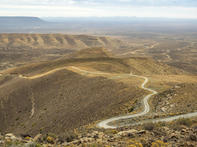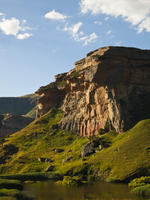Rich Organic Life
The lowest layer of the Karoo Supergroup is called Dwyka Tillite. Tillite is a motley collection of debris that is left behind when a glacier melts. This means that South Africa was once as cold as Scotland on a winter’s day, and covered in thick glaciers.

These ice-sheets were formed while the continent was slowly migrating across the South Pole. Once the sub-continent entered more temperate climes, the glaciers melted and created a large, composite swamp over much of Southern Africa. The rich organic life that flourished in these swamps and marshes would eventually consolidate into the substantial coal fields of the Ecca Group of rocks.
Rich in Fossils

As the climate dried things out even further, the Beaufort Group was deposited on the river floodplains. This layer is rich in fossils from the animals that roamed the fertile landscape of the Permian Age. These included strange, ‘mammal-like’ reptiles, which were initially investigated by Andrew Geddes Bain and are sometimes thought of as the first dinosaurs.
Andrew Geddes Bain was a protean man of many interests who fell in love with rocks while building roads for the British government in South Africa. He went on to become the ‘father’ of SA Geology, and one of SA’s pioneering padmakers to boot. Bain’s son, Thomas, also left his mark on South Africa and became the most important road builder of his time.
On top of the Beaufort Group came the Clarens Sandstones. This is a beautifully roseate layer of rock, prone to spectacular erosion that forms graceful, curving overhangs. These natural shelters were later used by the Bushmen for accommodation and as a canvas for their rock paintings. This rock layer is most definitely observed in the Golden Gate National Park, near the town of Clarens, in the eastern Free State.